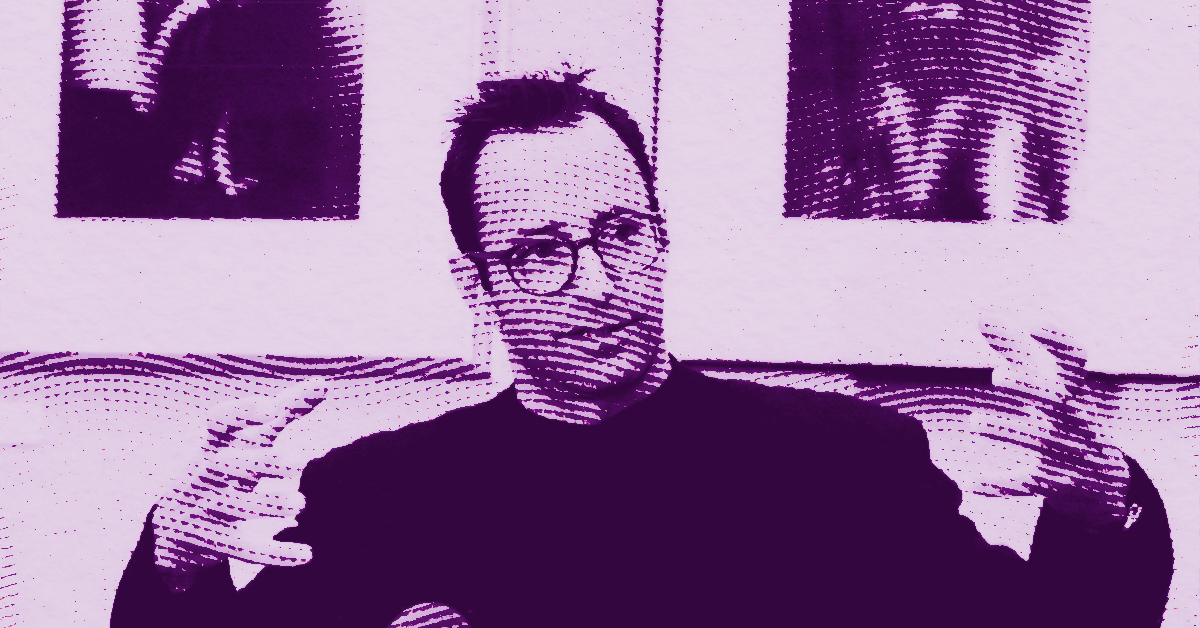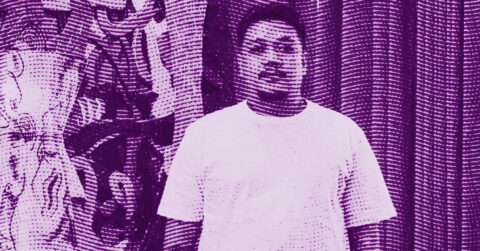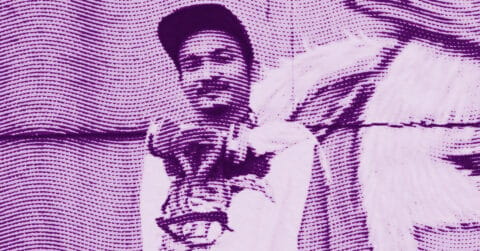Listen to me carefully, you bunch of snobs. When one contemplates Herb Ritts’s work today, more than twenty years after his passing, what strikes one first is not the obvious beauty of his models or the undeniable technical perfection of his images. No, what immediately captures the eye is this extraordinary ability that the American photographer had to erect visual monuments from a body, a drape, a simple play of shadows. For Ritts was not only a genius portraitist or a fashion virtuoso: he was the architect of a visual language that revolutionized our relationship to contemporary imagery.
Born in Los Angeles in 1952, Herbert Ritts Jr. paradoxically embodies this generation of artists who emerged in the 1980s without academic training, guided by an aesthetic instinct of rare purity. His initial career in the family furniture business, far from being anecdotal, already reveals this particular sensitivity to volumes and lines that would later characterize his photographic work. When he took a camera for the first time during that famous flat tire in the Californian desert with Richard Gere in 1978, Ritts did not just capture the image of a future actor: he laid the foundations of an aesthetic that would definitively mark the visual art of the late 20th century.
The legacy of architectural minimalism
Ritts’s work fits directly into the lineage of the great movements of formal simplification that swept Western art in the 20th century. Like the minimalist architecture developed by Ludwig Mies van der Rohe and Le Corbusier, his photography proceeds by subtraction [1]. Where his contemporaries saturated their images with effects and artifices, Ritts operated a methodical reduction, retaining only what was essential: light, form, raw emotion.
This minimalist approach finds its most accomplished expression in his famous nude photographs. Take the emblematic “Stephanie, Cindy, Christy, Tatjana, Naomi, Hollywood” from 1989: five supermodels entwined in the narrow corridor of his Hollywood studio. The image works according to the same principles as sleek modern architecture. Every superfluous element has been eliminated, no decor, no unnecessary accessories, not even clothing. Only the pure lines of the intertwined bodies remain, creating a geometric composition of striking sculptural power.
This will to strip down is not gratuitous. It responds to the same philosophy that animated the Bauhaus architects: to reveal the intrinsic beauty of form by eliminating all parasitic ornament. Like Mies van der Rohe with his steel and glass structures, Ritts built his images according to a rigorous geometry where each element finds its justification in the overall composition.
The influence of modern architecture also manifests itself in his way of handling space. His outdoor photographs, particularly those taken in the Californian desert, reveal an instinctive understanding of the relationship between figure and environment that echoes the spatial theories developed by modern architects. The vastness of the landscape does not serve as a mere backdrop: it becomes an integral part of the composition, creating this dynamic tension between the infinity of the place and the finiteness of the human body.
This architectural approach to the image reaches its peak in the 1990 series “Versace Dress, El Mirage,” where Christy Turlington stands in the dried bed of a Californian lake. The photograph works as an exercise in pure architecture: the model’s vertical body dialogues with the absolute horizontality of the desert, creating a composition of perfect geometric simplicity. Nothing disrupts this formal harmony, not even the folds of the fabric that mold the silhouette according to an unrelenting sculptural logic.
This aesthetic of spareness reveals an obvious kinship with the fundamental principles of modern architecture. Just as Le Corbusier defined architecture as “the skillful, correct, and magnificent play of volumes assembled under the light,” Ritts conceives his photographs as visual architectures where every element contributes to the overall balance of the composition. Indeed, his most successful images function like true monuments: they impose themselves on memory with the compelling clarity of great architectural achievements.
This architectural dimension of his work probably explains why his photographs withstand the test of time so well. Freed from any fashion effect, built according to timeless compositional principles, they possess that formal solidity characteristic of masterpieces of modern architecture. Twenty years after his death, Ritts’s work continues to assert itself with the same obviousness as a building by Mies van der Rohe or a Villa Savoye by Le Corbusier.
Greek sculpture revisited
But Ritts’s art also draws its sources from an older and no less decisive heritage: that of classical Greek sculpture. This influence, constantly claimed by the photographer himself, goes beyond mere aesthetic reference to constitute the very foundation of his artistic vision.
The bodies photographed by Ritts adhere to the same canons of beauty as the archaic Kouros or Polyclitus’s Doryphoros. This quest for plastic ideal is not a nostalgic academicism but a genuine contemporary rewriting of Greek aesthetic principles. When he photographs athletes like Jacqui Agyepong or dancers Pierre and Yuri, Ritts intuitively recaptures that exaltation of the human body in its physical perfection that animated ancient sculptors.
The Greek influence first appears in his conception of the male nude. His photographs of men, far from any erotic complacency, retrieve this celebration of virile beauty that characterized Greek art. The famous “Fred with Tires” from 1984 directly places the male body in the tradition of ancient heroes: perfectly sculpted musculature, noble and hieratic pose, expression of contained strength. Ritts does not photograph a model but reinvents the archetype of the Greek hero for contemporary times.
This sculptural approach to the body explains why his models always seem frozen in an eternal pose. Like Greek statues, Ritts’s photographs capture the instant when movement crystallizes into pure beauty. His dancers and athletes do not move: they embody the Platonic idea of perfect movement, that impossible synthesis between impulse and balance that only art can realize.
Light plays in this aesthetic the same role as marble in ancient sculpture: it reveals the form while enhancing it. Ritts mastered this technique of natural lighting that allowed Greek sculptors to make the surface of their works vibrate. His outdoor photographs systematically exploit this Californian “golden hour” which transforms bodies into volumes of pure light, thus recovering that translucency effect that the ancient masters achieved by polishing marble.
This sculptural dimension of his work culminates in his photographs of female nudes. Naomi Campbell photographed in the Californian desert irresistibly evokes these Hellenistic Venuses where formal perfection combines with the expression of restrained sensuality. Ritts never seeks the easy effect or gratuitous provocation: he finds that nobility of Greek art that knew how to celebrate the beauty of the body without ever falling into vulgarity.
The Greek influence also shows in his conception of space. Like ancient sculptors who designed their works to dialogue with the architecture of temples, Ritts systematically places his models in an environment that magnifies them. His Californian deserts function like architectural settings where bodies take on a monumental dimension, thus regaining that heroic grandeur which characterized Greek art at its height.
This Greek lineage is not only aesthetic: it is also philosophical. Like artists of Antiquity, Ritts believes in the possibility of revealing, through art, an ideal beauty that transcends the contingencies of reality. His photographs do not document: they transfigure. They do not show particular bodies but reveal the universal idea of bodily beauty, thus recovering that metaphysical ambition that animated classical Greek art.
This timeless dimension of his work explains why his photographs continue to move us today. Freely of any overly precise temporal anchoring, constructed according to universal aesthetic principles, they possess that formal evidence which characterizes the masterpieces of Greek art. By revealing the eternal beauty of the human body under the ruthless light of modernity, Ritts achieved this tour de force: making something new out of the old, revolutionizing photographic art by resurrecting the ancient ideal.
The legacy of a visionary
Herb Ritts’s work today stands as one of the most striking testimonies of this ability that authentic art has to reconcile tradition and modernity. By combining the heritage of modern architecture and that of Greek sculpture, the American photographer invented a visual language of absolute modernity that nevertheless draws its strength from the oldest sources of Western art.
This synthesis was only possible at a very particular moment in American cultural history, when Los Angeles was emerging as a new global artistic capital and when photography was definitively achieving the status of major art. Ritts embodies this generation of artists who, without denying the European heritage, knew how to invent a specifically American classicism, nourished by Californian light and the conquering optimism of the 1980s.
His influence on contemporary photography remains considerable. From current advertising campaigns to portfolios of young photographers, Herb Ritts’ imprint is found everywhere: this search for formal purity, this exaltation of bodily beauty, this ability to transform the everyday into a visual epiphany. As Naomi Campbell, one of his favorite models, wrote: “In fashion, we no longer see that kind of images” [2]. This nostalgic remark reveals the magnitude of the void left by the master’s passing.
Because Ritts represented more than just a fashion or celebrity photographer: he embodied a certain idea of American art, fully capable of embracing its commercial dimension without ever sacrificing aesthetic rigor. His campaigns for Versace or Calvin Klein elevated advertising to the level of art, proving that there is no impermeable boundary between pure creation and commercial commission when talent is present.
This lesson resonates with particular poignancy in our era, where art and commerce seem more inseparable than ever. Ritts’ example demonstrates that it is possible to reconcile artistic ambition and commercial success, provided one never compromises on formal quality. His most “commercial” photographs, those of Madonna or Richard Gere, remain full-fledged artworks, able to move us independently of their original promotional function.
This artistic integrity explains why Ritts’ work has aged so well. At a time when so many contemporary visual productions age before they are even disseminated, his photographs retain that freshness and clarity characteristic of the classics. They remind us that in art, only beauty matters, that absolute formal beauty that transforms any subject into an aesthetic revelation.
Ritts’ legacy extends far beyond photography alone. His influence reaches the whole of contemporary visual culture, from cinema to fashion to advertising. The aesthetic of radiant simplicity that he helped define continues to permeate our collective imagination, proving that an authentic artist does not merely reflect his era: he shapes it for future generations.
Herb Ritts achieved what all great artists attempt: inscribing his name in the prestigious lineage stretching from Phidias to Le Corbusier, from Praxiteles to Mies van der Rohe. He proved that photographic art, when it attains this absolute formal quality, can rival the noblest expressions of Western art. And above all, he demonstrated that beauty, far from being an outdated concept, remains the highest aspiration of any worthy artistic creation.
- Martineau, Paul. Herb Ritts: L.A. Style, Getty Publications, 2012.
- Campbell, Naomi. Interview in The Guardian, “Naomi Campbell on Herb Ritts”, March 30, 2012.
















